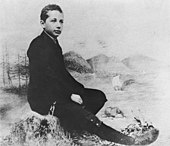| Have you seen this man? Source: Wikipedia |
How titillating could it possibly be to triumphantly stick out one's tongue at an entire scientific community after proving all its worldly theories inadequate? Well, like the explanations to many phenomena in our universe, the answer to this question lies once again in the mind of Albert Einstein. Undoubtedly--and his late cousin, Elsa Einstein, would have wholeheartedly agreed with me--this man is the sexiest man who has ever lived on planet Earth, and sought to think beyond it.
Chances are, at some point in your high school life, you've come across the wonderful wall painting in our building that bears the equation "E=mc^2". First proposed in 1905, Einstein's Theory of Special Relativity has, till this day, been one of the greatest breakthroughs in cosmic exploration. It is with this theory that Einstein proves the three dimensions known to man to be mere relative values, asserts that time is a vital fourth dimension, observes that the speed of light is always constant, shows that mass and energy are interchangeable, brings forth the concept of spacetime, and thus belittles all other scientists in his field. Check out his website, einstein.biz!
But surely, even a great man like him was once a crying toddler?
 |
| Three-year-old Einstein Source: Wikipedia |
Born in Germany to Hermann Einstein and Pauline Coch, little Einstein started schooling at a Catholic elementary school after he turned five. He stayed there for three years and transferred to the Luitpold Gymnasium to receive advanced primary and secondary school education for the next seven years until he left Germany. (The Luitpold Gymnasium is now called the Albert Einstein Gymnasium, and I dare say this has been a name-change for the better.)
Like many familar stories about some scientists being intellectually late bloomers, I'm sure you've heard about how Einstein was allegedly notorious for bad grades in school. In actuality, this is a hoax- his archives found in his high school show that he positively excelled in all his classes. Splendid, now I can no longer find comfort in thinking that a good future can await me despite my sometimes less-than-stellar academic performance.
 |
| Fourteen-year-old Einstein Source: Wikipedia |
One day, Einstein's dad showed him a pocket compass. Immediately, the young scientist-in-the-making realized that there had to be a mechanism causing the needle to move; a profound interest in theoretical physics was thus manifested in him. As he grew older, Einstein built many models and mechanical devices for his amusement and began to explore mathematics. Remember, questioning the universe as a whining child is the first telling sign of intellect beyond measure; so if you ever feel something stirring within your chest, and find yourself relating quantum mechanics to bacon, you'll know you're on the right track.
By the time Einstein was fifteen, his father's business had failed and therefore caused him to move the family to Italy. Back in Germany, Einstein was made to finish his studies, but he absolutely detested the teaching methods of his school; he constantly expressed distaste for what he called 'rote learning', where lessons only entailed memorization. Eventually, he convinced his school to let him go after conjuring up a doctor's note, and joined his family in Italy. It was during his stay in Italy that he wrote his short essay 'On the Investigation of the State of the Ether (theorized medium) in a Magnetic Field'. Well, when I was fifteen, I did not start my ISP essay until the night before, and proceeded to leave seven paragraphs for the next morning...
When Einstein turned sixteen, he took the entrance exams for the Swiss Federal Polytechnic in Zurich. His results in the physics and mathematics sections were exceeding expectations, but he failed the exam as a whole. After listening to advice from the principal of the polytechnic, Einstein decided to finish his schooling in the Argovian Secondary School in Aarau, Switzerland.
And then he went back and officially enrolled in that polytechnic when he was seventeen. Now, now, what has he done with my self-esteem?
Sources
"Albert Einstein." Albert Einstein. Web. 19 Jan. 2015. <http://einstein.biz/biography.php>.
"Albert Einstein." Wikipedia. Wikimedia Foundation. Web. 19 Jan. 2015. <http://en.wikipedia.org/wiki/Albert_Einstein>.
Wikipedia. Wikimedia Foundation. Web. 19 Jan. 2015. <http://en.wikipedia.org/wiki/Theory_of_relativity#On_the_theory_of_relativity>.



